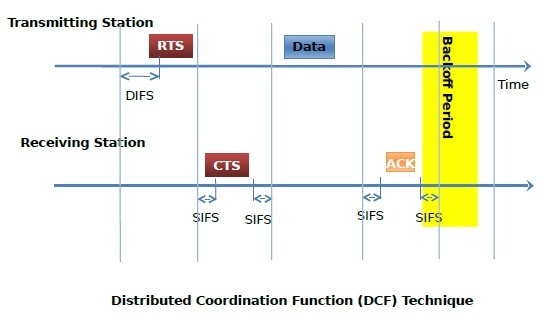
 Data Structure
Data Structure Networking
Networking RDBMS
RDBMS Operating System
Operating System Java
Java MS Excel
MS Excel iOS
iOS HTML
HTML CSS
CSS Android
Android Python
Python C Programming
C Programming C++
C++ C#
C# MongoDB
MongoDB MySQL
MySQL Javascript
Javascript PHP
PHP
- Selected Reading
- UPSC IAS Exams Notes
- Developer's Best Practices
- Questions and Answers
- Effective Resume Writing
- HR Interview Questions
- Computer Glossary
- Who is Who
Distributed Coordination Function (DCF)
Distributed coordination function (DCF) is a mandatory technique used to prevent collisions in IEEE 802.11-based WLAN standard (Wi-Fi). It is a medium access control (MAC) sublayer technique used in areas where carrier-sense multiple access with collision avoidance (CSMA/CA) is used.
Technique
The basic technique of DCF is as follows −
-
When a station has a frame to transmit, it waits for a random backoff time. The random backoff time is defined by a contention window having a random number of time slots. The backoff time is given by the following equation −
Timebackoff = random()×Timeslots
Here, the function generates a random number and is the time period for one slot.
If the station senses that the channel is busy during the contention period, it pauses its timer till the channel is clear.
At the end of the backoff period, if the channel is clear, the station will wait for an amount of time equal to DIFS (Distributed Inter-Frame Space) and sense the channel again.
If the channel is still clear, the station transmits a RTS (request to send) frame.
The destination station responds using a CTS (clear to send) frame if it is available.
Then the transmitting station sends the data frames.
After the frames are sent, the transmitting station waits for a time equal to SIFS (Short Inter-Frame Space) for the acknowledgement.
At the end of this transmission process, the station again waits for the backoff time before the next transmission.
The technique is shown in the following diagram −


